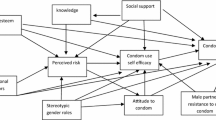Abstract
Two-hundred-and-thirty-one Chinese women were individually interviewed on their HIV-prevention behavior and gender-related psychosocial factors. Compared to women with intact marriages, women with marital disruption endorsed more inaccurate information about HIV/AIDS, had less worry about contracting HIV from their husbands, and were less likely to use condoms in current and future sexual activities. Among sexually active Chinese married women, rates of condom use in the past 6 months were 60% for the intact group and 38% for the disrupted group. Factors that discriminated between condom non-users and users among sexually active women in the disrupted group included: conservative gender attitudes toward sexuality and sexual decision-making, negative attitudes toward condom use, and lack of concern about contracting HIV from their husbands.
Similar content being viewed by others
References
Baker, J. C., Battle, R. S., Cummings, G. L., & Bancroft, K. N. (1998). Condoms and consequences: HIV/AIDS education and African American women. Human Organization, 57, 273–283.
Beadnell, B., Baker, S., Morrison, D., & Knox, K. (2000). HIV/STD risk factors for women with violent male partners. Sex Roles, 42, 661–669.
Cheung, F., & Tang, C. (2008). Women’s lives in contemporary Chinese societies. In U. P. Gielen, & J. L. Gibbons (Eds.), Women around the world: Psychosocial perspectives. Greenwich, CT: Information Age, in press.
Connell, K. W. (1987). Gender and power. Stanford, CA: Stanford University Press.
Davis, C., Tang, C., Chan, S., & Noel, B. (1999). The development and validation of the International AIDS Questionnaire—Chinese version (IAQ-C). Educational and Psychological Measurement, 59, 481–491.
Fishbein, M., & Ajzen, I. (1975). Belief, attitude, intention, and behavior: An introduction to theory and research. Reading, MA: Addision-Wesley.
Futures Group (2002). Attitudes toward HIV/AIDS in China: Research on public knowledge, attitudes, and behavior in cities and towns. China: Futures Group.
Fung, E., & Chung, S. (1999). Survey on women & AIDS. Hong Kong: St. John’s Cathedral HIV Information and Drop-in Center.
Janz, N., & Becker, M. (1984). The health belief model: A decade later. Health Education Quarterly, 11, 1–47.
Kung, W. W., Hung, S., & Chan, C. (2004). How the socio-cultural contexts shapes women’s divorce experiences in Hong Kong. Journal of Comparative Family Studies, 35, 33–50.
Lau, J., & Thomas, J. (2001). Risk behaviors of Hong Kong male residents traveling to mainland China: A potential bridge population for HIV infection. AIDS Care, 13, 71–81.
Logan, T. K., Cole, J., & Leukefeld, C. (2002). Women, sex, and HIV: Social and contextual factors, meta-analysis of published interventions, and implications for practice and research. Psychological Bulletin, 128, 851–885.
Miller, J. (1986). Toward a new psychology of women. Boston: Beacon.
Misovich, S., Fisher, J., & Fisher, W. (1997). Close relationships and elevated HIV risk behavior. Evidence and possible underlying psychological processes. Review of General Psychology, 1, 72–107.
O’Leary, A. (2000). Women at risk for HIV from a primary partner: Balancing risk and intimacy. Annual Review of Sex Research, 11, 191–234.
Sheeran, P., Abraham, C., & Orbell, S. (1999). Psychosocial correlates of heterosexual condom use: A meta-analysis. Psychological Bulletin, 125, 90–132.
Sobo, E. (1993). Inner-city women and AIDS: The psychosocial benefits of unsafe sex. Culture, Medicine, & Psychiatry, 17, 455–485.
Tang, C. (1999a). Marital power and aggression in a community sample of Hong Kong Chinese families. Journal of Interpersonal Violence, 14, 586–602.
Tang, C. (1999b). Wife abuse in Hong Kong Chinese families: A community survey. Journal of Family Violence, 14, 173–191.
Tang, C., Wong, C., & Lee, A. (2001). Gender-related psychosocial and cultural factors associated with condom use among Chinese married women. AIDS Education and Prevention, 13, 329–342.
Tucker, J., Henderson, G., Wang, T., Huang, Y., Parish, W., Pan, S., et al. (2005). Surplus men, sex work, and the spread of HIV in China. AIDS, 19, 539–547.
United Nations Program on HIV/AIDS (UNAIDS) (2006). 2006 Report on the global AIDS epidemic. Geneva, Switzerland: United Nations Program on HIV/AIDS (UNAIDS).
United Nations Program on HIV/AIDS, United Nations Population Fund, & United Nations Development Fund for Women (UNAIDS, UNFPA, & UNIFEM) (2004). Women and HIV/AIDS: Confronting the crisis. Geneva, Switzerland: United Nations Program on HIV/AIDS, United Nations Population Fund, & United Nations Development Fund for Women (UNAIDS, UNFPA, & UNIFEM).
United Nations Program on HIV/AID & World Health Organization (UNAIDS & WHO) (2004). Treat 3 million by 2005: Epidemiological fact sheets on HIV/AIDS and sexually transmitted infections, China. Geneva, Switzerland: United Nations Program on HIV/AID & World Health Organization (UNAIDS & WHO).
Wingood, G., & DiClemente, R. (2000). Application of the theory of gender and power to examine HIV-related exposures, risk factors, and effective intervention for women. Health Education & Behavior, 27, 539–565.
Wong, C. Y., & Tang, C. (2001). Understanding heterosexual Chinese college student’s intention to adopt safer sex behaviors. Journal of Sex Research, 38, 118–126.
Zhang, K., Li, D., Li, h., & Beck, J. (1999). Changing sexual attitudes and behaviors in China: Implications for the spread of HIV and other sexually transmitted diseases. AIDS Care, 11, 581–589.
Author information
Authors and Affiliations
Corresponding author
Appendix
Appendix
Items on Perceived Husband Reaction to Condom Use
Husband becoming violent
丈夫變得暴力
Husband insisting on condomless sexual activities
丈夫堅持不用安全套進行性行為
Husband sulking and stopping sexual activities with me
丈夫停止跟我進行性行為並不再理睬我
Husband turning to other women for condomless sexual activities
丈夫與其他女性不使用安全套進行性行為
Husband suspecting me of sexual infidelity
丈夫懷疑我有婚外性行為
Husband making jokes about using condoms
丈夫取笑用安全套進行性行為
Husband complaining of reduced sexual satisfaction in using condoms
丈夫投訴使用安全套會減低性滿足
Rights and permissions
About this article
Cite this article
Tang, C.Sk. The Influence of Gender-related Factors on HIV Prevention among Chinese Women with Disrupted Marital Relationship. Sex Roles 59, 119–126 (2008). https://doi.org/10.1007/s11199-008-9421-7
Received:
Accepted:
Published:
Issue Date:
DOI: https://doi.org/10.1007/s11199-008-9421-7




